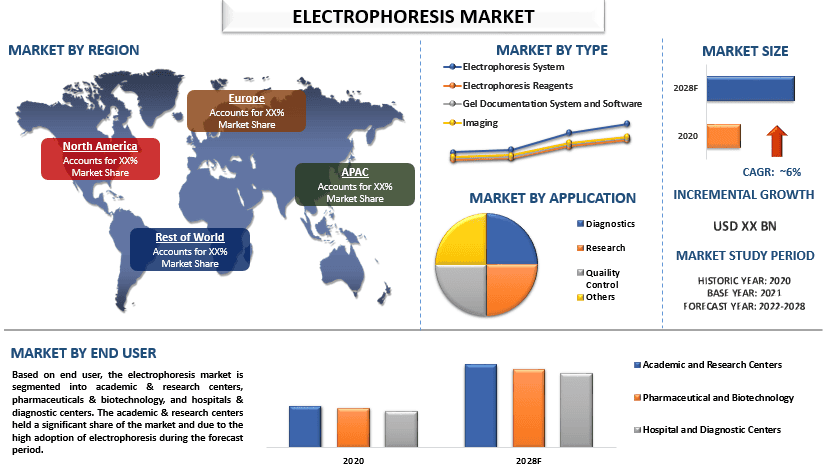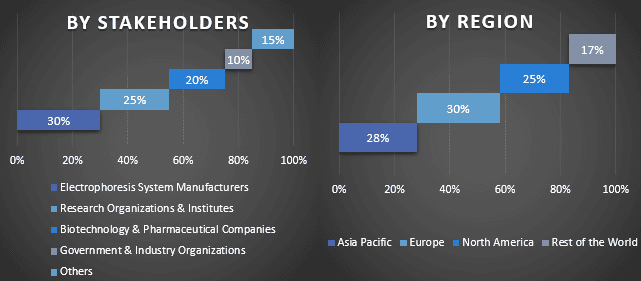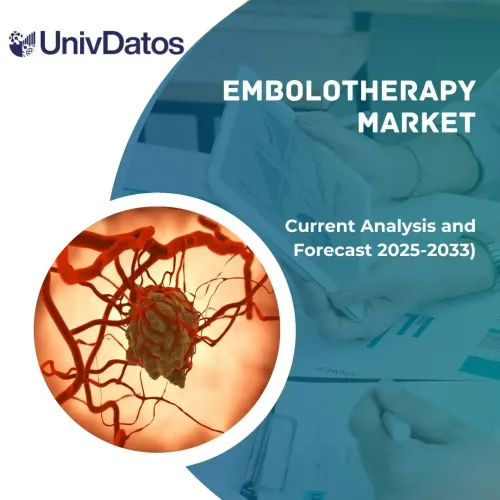- Trang chủ
- Về chúng tôi
- Ngành
- Dịch vụ
- Đọc
- Liên hệ với chúng tôi
Thị trường Điện di: Phân tích Hiện tại và Dự báo (2022-2028)
Nhấn mạnh vào Loại (Hệ thống điện di, Thuốc thử điện di, Hệ thống và Phần mềm ghi nhận gel, và Hình ảnh); Ứng dụng (Chẩn đoán, Nghiên cứu, Kiểm soát chất lượng và Các ứng dụng khác); Người dùng cuối (Trung tâm Nghiên cứu & Học thuật, Dược phẩm & Công nghệ sinh học, và Bệnh viện & Trung tâm chẩn đoán); và Khu vực/Quốc gia

Thị trường Điện di Toàn cầu dự kiến sẽ tăng trưởng với tốc độ đáng kể khoảng 6% trong giai đoạn dự báo. Điện di được định nghĩa là sự chuyển động của một hạt tích điện trong môi trường có điện trường. Nhiều thành phần sinh học quan trọng, bao gồm axit amin, peptit, protein, nucleotide và axit nucleic, bao gồm các nhóm ion hóa và do đó tồn tại dưới dạng các loài tích điện (anion hoặc cation) trong dung dịch ở bất kỳ độ pH nhất định nào. Trong những năm gần đây, nhu cầu về hệ thống và thuốc thử điện di đã tăng lên đáng kể do việc áp dụng ngày càng nhiều các vật tư tiêu hao kết hợp với việc ứng dụng ngày càng tăng của điện di trong lĩnh vực proteomics, genomics, khám phá thuốc, sản xuất kháng thể, y học cá nhân hóa, v.v. Cùng với đó, các yếu tố như sự gia tăng tỷ lệ mắc các bệnh mãn tính, sự ra mắt sản phẩm mới, cùng với sự hợp tác & quan hệ đối tác ngày càng tăng giữa các công ty hàng đầu và các viện nghiên cứu cũng góp phần vào sự tăng trưởng của thị trường điện di. Ví dụ: vào tháng 9 năm 2021, SCIEX đã công bố ra mắt giải pháp điện di mao quản, “hệ thống BioPhase 8800”, một sản phẩm hiện đại. Hệ thống là một thiết bị đa mao quản tiên tiến, sáng tạo, có thể xử lý đồng thời tám mẫu trong khi đảm bảo tính nhất quán của mẫu và cung cấp các phát hiện chính xác.
Bio-Rad Laboratories, GE Healthcare, Thermo Fisher Scientific, Inc., Danaher Corporation, Agilent Technologies, Merck Group, PerkinElmer, Inc., Harvard Bioscience, QIAGEN N.V. và Lonza Group Ltd. là một số công ty chủ chốt trên thị trường. Một số hoạt động M&A cùng với quan hệ đối tác đã được thực hiện bởi những công ty này để tạo điều kiện cho khách hàng các sản phẩm/công nghệ sáng tạo và công nghệ cao.
Thông tin chi tiết được trình bày trong báo cáo
“Trong số các loại hình, danh mục thuốc thử điện di sẽ thống trị thị trường trong giai đoạn dự báo”
Dựa trên loại hình, thị trường được phân thành hệ thống điện di, thuốc thử điện di, hệ thống và phần mềm ghi hình gel và hình ảnh. Phân khúc thuốc thử điện di đang thống trị thị trường và dự kiến sẽ tăng trưởng đáng kể trong giai đoạn dự báo do việc áp dụng ngày càng nhiều các vật tư tiêu hao kết hợp với việc ứng dụng ngày càng tăng của điện di trong lĩnh vực proteomics, genomics, khám phá thuốc, sản xuất kháng thể, y học cá nhân hóa, v.v. Cùng với đó, thị trường điện di đang mở rộng do các yếu tố bao gồm tần suất mắc các bệnh mãn tính ngày càng tăng, số lượng sản phẩm ra mắt ngày càng tăng cũng như các quan hệ đối tác và hợp tác giữa các công ty hàng đầu và các tổ chức học thuật. Hơn nữa, các hệ thống điện di được phân chia thành các hệ thống điện di gel và hệ thống điện di mao quản.
“Trong số các ứng dụng, phân khúc nghiên cứu sẽ chiếm một thị phần đáng kể trên thị trường vào năm 2020”
Trên cơ sở ứng dụng, thị trường được phân loại thành chẩn đoán, nghiên cứu, kiểm soát chất lượng và các loại khác. Trong số đó, phân khúc nghiên cứu chiếm một thị phần đáng kể trên thị trường vào năm 2020. Điều này chủ yếu là do việc ứng dụng ngày càng tăng của điện di trong khám phá thuốc, genomics và proteonomics. Cùng với đó, việc áp dụng ngày càng nhiều phương pháp giải trình tự thế hệ tiếp theo và xác định các dấu ấn sinh học cũng dự kiến sẽ cải thiện tỷ lệ chấp nhận điện di và vật tư tiêu hao trong lĩnh vực nghiên cứu.
“Trong số những người dùng cuối, phân khúc học thuật & nghiên cứu chiếm một thị phần đáng kể trên thị trường vào năm 2020”
Dựa trên người dùng cuối, thị trường điện di được phân thành các trung tâm học thuật & nghiên cứu, dược phẩm & công nghệ sinh học và bệnh viện & trung tâm chẩn đoán. Các trung tâm học thuật & nghiên cứu chiếm một thị phần đáng kể trên thị trường và do việc áp dụng rộng rãi điện di trong giai đoạn dự báo. Điều này chủ yếu là do tỷ lệ chấp nhận điện di ngày càng tăng trong lĩnh vực khám phá và phát triển thuốc, genomics, proteomics và y học chính xác.
“Bắc Mỹ sẽ chiếm một thị phần đáng kể trên thị trường”
Vào năm 2020, Bắc Mỹ chiếm một thị phần đáng kể trên thị trường điện di toàn cầu. Điều này chủ yếu là do sự gia tăng đầu tư từ chính phủ và khu vực tư nhân cùng với các hoạt động nghiên cứu và phát triển ngày càng tăng về các liệu pháp mới. Hơn nữa, sự gia tăng liên tục về tỷ lệ mắc các bệnh mãn tính bao gồm ung thư và tiểu đường, cũng dự kiến sẽ thúc đẩy sự tăng trưởng của thị trường trong giai đoạn dự báo. Hơn nữa, việc tăng cường hợp tác và quan hệ đối tác trong khu vực cũng dự kiến sẽ thúc đẩy thị trường điện di. Ví dụ: vào tháng 6 năm 2021, Thermo Fisher Scientific đã ký một thỏa thuận với Advanced Electrophoresis Solutions Ltd với mục tiêu đẩy nhanh quá trình phát triển phương pháp điều trị bằng cách sử dụng Phân tích Protein Cắt Cạnh. Tuy nhiên, chi phí bảo trì thiết bị cao dự kiến sẽ hạn chế sự tăng trưởng của thị trường trong khu vực.
Lý do nên mua báo cáo này:
- Nghiên cứu bao gồm phân tích định cỡ và dự báo thị trường được xác thực bởi các chuyên gia đầu ngành quan trọng đã được xác thực.
- Báo cáo trình bày một đánh giá nhanh về hiệu quả hoạt động chung của ngành trong nháy mắt.
- Báo cáo bao gồm một phân tích chuyên sâu về các đối thủ trong ngành nổi bật với trọng tâm chính vào tài chính kinh doanh quan trọng, danh mục sản phẩm, chiến lược mở rộng và các phát triển gần đây.
- Kiểm tra chi tiết các động lực, hạn chế, xu hướng chính và cơ hội hiện hành trong ngành.
- Nghiên cứu bao gồm toàn diện thị trường trên các phân khúc khác nhau.
- Phân tích sâu cấp khu vực của ngành.
Tùy chọn tùy chỉnh:
Thị trường điện di toàn cầu có thể được tùy chỉnh thêm theo yêu cầu hoặc bất kỳ phân khúc thị trường nào khác. Bên cạnh đó, UMI hiểu rằng bạn có thể có nhu cầu kinh doanh riêng, vì vậy hãy thoải mái liên hệ với chúng tôi để nhận được một báo cáo hoàn toàn phù hợp với yêu cầu của bạn.
Mục lục
Phương Pháp Nghiên Cứu Phân Tích Thị Trường Điện Di (2022-2028)
Phân tích thị trường lịch sử, ước tính thị trường hiện tại và dự báo thị trường tương lai của thị trường điện di toàn cầu là ba bước chính được thực hiện để tạo và phân tích sự chấp nhận điện di ở các khu vực lớn trên toàn cầu. Nghiên cứu thứ cấp chuyên sâu đã được thực hiện để thu thập số liệu thị trường lịch sử và ước tính quy mô thị trường hiện tại. Thứ hai, để xác thực những hiểu biết sâu sắc này, nhiều phát hiện và giả định đã được xem xét. Hơn nữa, các cuộc phỏng vấn sơ cấp chuyên sâu cũng được thực hiện với các chuyên gia trong ngành trên toàn bộ chuỗi giá trị của thị trường điện di toàn cầu. Sau khi giả định và xác thực số liệu thị trường thông qua các cuộc phỏng vấn sơ cấp, chúng tôi đã sử dụng phương pháp tiếp cận từ trên xuống/từ dưới lên để dự báo quy mô thị trường hoàn chỉnh. Sau đó, các phương pháp phân chia thị trường và phân tích dữ liệu tam giác đã được áp dụng để ước tính và phân tích quy mô thị trường của các phân khúc và phân khúc phụ của ngành liên quan đến. Phương pháp chi tiết được giải thích dưới đây:
Phân Tích Quy Mô Thị Trường Lịch Sử
Bước 1: Nghiên Cứu Chuyên Sâu Các Nguồn Thứ Cấp:
Nghiên cứu thứ cấp chi tiết đã được thực hiện để thu thập quy mô thị trường lịch sử của thị trường điện di thông qua các nguồn nội bộ của công ty như báo cáo thường niên & báo cáo tài chính, bản trình bày hiệu suất, thông cáo báo chí, v.v. và các nguồn bên ngoài bao gồm tạp chí, tin tức & bài viết, ấn phẩm của chính phủ, ấn phẩm của đối thủ cạnh tranh, báo cáo ngành, cơ sở dữ liệu của bên thứ ba và các ấn phẩm đáng tin cậy khác.
Bước 2: Phân Khúc Thị Trường:
Sau khi có được quy mô thị trường lịch sử của thị trường điện di, chúng tôi đã tiến hành phân tích thứ cấp chi tiết để thu thập thông tin chi tiết và chia sẻ thị trường lịch sử cho các phân khúc & phân khúc phụ khác nhau cho các khu vực lớn. Các phân khúc chính được bao gồm trong báo cáo như loại, ứng dụng và người dùng cuối. Phân tích cấp quốc gia sâu hơn đã được thực hiện để đánh giá mức độ chấp nhận chung của các mô hình thử nghiệm ở khu vực đó.
Bước 3: Phân Tích Yếu Tố:
Sau khi thu được quy mô thị trường lịch sử của các phân khúc và phân khúc phụ khác nhau, chúng tôi đã tiến hành phân tích yếu tố chi tiết để ước tính quy mô thị trường hiện tại của thị trường điện di. Hơn nữa, chúng tôi đã tiến hành phân tích yếu tố bằng cách sử dụng các biến phụ thuộc và độc lập như các loại, ứng dụng và người dùng cuối khác nhau của điện di. Một phân tích kỹ lưỡng đã được thực hiện cho các kịch bản cung và cầu xem xét các quan hệ đối tác hàng đầu, sáp nhập và mua lại, mở rộng kinh doanh và ra mắt sản phẩm trong lĩnh vực thị trường điện di trên toàn cầu.
Ước Tính & Dự Báo Quy Mô Thị Trường Hiện Tại
Định Cỡ Thị Trường Hiện Tại: Dựa trên những hiểu biết sâu sắc có thể hành động từ 3 bước trên, chúng tôi đã đạt được quy mô thị trường hiện tại, những người chơi chính trong thị trường điện di toàn cầu và thị phần của các phân khúc. Tất cả các tỷ lệ phần trăm cần thiết và sự phân chia thị trường đã được xác định bằng cách sử dụng phương pháp thứ cấp đã đề cập ở trên và được xác minh thông qua các cuộc phỏng vấn sơ cấp.
Ước Tính & Dự Báo: Để ước tính và dự báo thị trường, trọng số đã được gán cho các yếu tố khác nhau bao gồm động lực & xu hướng, hạn chế và cơ hội có sẵn cho các bên liên quan. Sau khi phân tích các yếu tố này, các kỹ thuật dự báo liên quan, tức là phương pháp tiếp cận từ trên xuống/từ dưới lên đã được áp dụng để đưa ra dự báo thị trường cho năm 2028 cho các phân khúc và phân khúc phụ khác nhau trên các thị trường lớn trên toàn cầu. Phương pháp nghiên cứu được áp dụng để ước tính quy mô thị trường bao gồm:
- Quy mô thị trường của ngành, về mặt doanh thu (USD) và tỷ lệ chấp nhận của thị trường điện di trên khắp các thị trường lớn trong nước
- Tất cả các tỷ lệ phần trăm, sự phân chia và chia nhỏ của các phân khúc và phân khúc phụ của thị trường
- Những người chơi chính trong thị trường điện di toàn cầu về các sản phẩm được cung cấp. Ngoài ra, các chiến lược tăng trưởng được các nhà chơi này áp dụng để cạnh tranh trên thị trường đang phát triển nhanh chóng
Xác Thực Quy Mô và Thị Phần Thị Trường
Nghiên Cứu Sơ Cấp: Các cuộc phỏng vấn chuyên sâu đã được thực hiện với các Nhà Lãnh Đạo Ý Kiến Chủ Chốt (KOLs) bao gồm các Giám Đốc Điều Hành Cấp Cao (CXO/VP, Trưởng Phòng Kinh Doanh, Trưởng Phòng Marketing, Trưởng Phòng Vận Hành, Trưởng Phòng Khu Vực, Trưởng Phòng Quốc Gia, v.v.) trên khắp các khu vực lớn. Các phát hiện nghiên cứu sơ cấp sau đó đã được tóm tắt và phân tích thống kê đã được thực hiện để chứng minh giả thuyết đã nêu. Đầu vào từ nghiên cứu sơ cấp đã được hợp nhất với các phát hiện thứ cấp, do đó biến thông tin thành những hiểu biết sâu sắc có thể hành động.
Phân Chia Người Tham Gia Sơ Cấp ở Các Khu Vực Khác Nhau

Kỹ Thuật Thị Trường
Kỹ thuật phân tích dữ liệu tam giác đã được sử dụng để hoàn thành ước tính thị trường tổng thể và để đưa ra các số liệu thống kê chính xác cho từng phân khúc và phân khúc phụ của thị trường điện di toàn cầu. Dữ liệu được chia thành một số phân khúc & phân khúc phụ sau khi nghiên cứu các thông số và xu hướng khác nhau trong các lĩnh vực loại, ứng dụng và người dùng cuối trong thị trường điện di toàn cầu.
Mục Tiêu Chính của Nghiên Cứu Thị Trường Điện Di Toàn Cầu
Các xu hướng thị trường hiện tại & tương lai của thị trường điện di toàn cầu đã được xác định rõ trong nghiên cứu. Các nhà đầu tư có thể đạt được những hiểu biết chiến lược để làm cơ sở cho quyết định đầu tư của họ dựa trên phân tích định tính và định lượng được thực hiện trong nghiên cứu. Các xu hướng thị trường hiện tại và tương lai xác định sức hấp dẫn tổng thể của thị trường ở cấp độ khu vực, cung cấp một nền tảng cho người tham gia công nghiệp khai thác thị trường chưa được khai thác để hưởng lợi từ lợi thế của người đi đầu. Các mục tiêu định lượng khác của các nghiên cứu bao gồm:
- Phân tích quy mô thị trường hiện tại và dự báo của thị trường điện di về giá trị (USD). Ngoài ra, phân tích quy mô thị trường hiện tại và dự báo của các phân khúc và phân khúc phụ khác nhau
- Các phân khúc trong nghiên cứu bao gồm các lĩnh vực loại, ứng dụng và người dùng cuối.
- Xác định và phân tích khung pháp lý cho điện di
- Phân tích chuỗi giá trị liên quan đến sự hiện diện của nhiều trung gian khác nhau, cùng với việc phân tích hành vi của khách hàng và đối thủ cạnh tranh của ngành.
- Phân tích quy mô thị trường hiện tại và dự báo của thị trường điện di cho khu vực chính.
- Các quốc gia lớn của các khu vực được nghiên cứu trong báo cáo bao gồm Châu Á Thái Bình Dương, Châu Âu, Bắc Mỹ và Phần Còn Lại của Thế Giới.
- Hồ sơ công ty của thị trường điện di và các chiến lược tăng trưởng được các nhà chơi thị trường áp dụng để duy trì trên thị trường đang phát triển nhanh chóng
- Phân tích sâu cấp khu vực của ngành
Liên quan Báo cáo
Khách hàng đã mua mặt hàng này cũng đã mua










